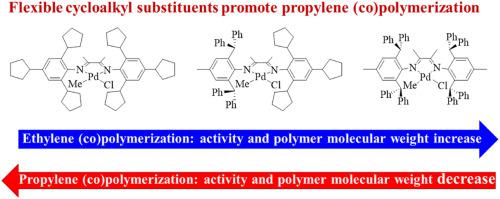Polymer ( IF 4.1 ) Pub Date : 2022-06-20 , DOI: 10.1016/j.polymer.2022.125076 Huijun Fan , Yudan Liao , Shengyu Dai

|
The aryl substituents as well as backbones in the α-diimine catalysts have a significant influence on the olefin (co)polymerization. In this work, the effect of the cycloalkyl and dibenzhydryl substituents as well as backbones of the α-diimine Pd(II) catalysts on the propylene polymerization and copolymerization has been explored. The Pd(II) catalysts led to the moderate activities (level of 104 g mol−1 h−1), tunable molecular weights (5.6–125.2 kg/mol) and highly branched (155–249/1000C) polypropylene during homopolymerization. Among the catalysts, the catalyst Pd3 with the cyclopentyl substituents and dimethyl backbone resulted in the highest molecular weight and activity in the propylene polymerization. Moreover, during the copolymerization of polypropylene-MA, the Pd(II) catalysts showed low activities and yielded low to moderate molecular weight (Mn up to 39.8 kg/mol) polar functionalized copolymers with high branching density (134–217/1000C) and tunable incorporation ratios (1.0–11.5 mol%). Overall, the catalyst Pd3 was also observed to be optimal for the copolymerization reaction, owing to the excellent copolymerization ability of propylene with MA and some other acrylic derived monomers. Further, the rigid substituents with a high steric hindrance played an unfavorable role during the (co)polymerization, which was contrary to the ethylene polymerization. In summary, compared with the rigid bulky dibenzhydryl substituents, the cyclopentyl substituents not only endowed the propylene homopolymerization system with the highest molecular weight and activity, but also provided the copolymerization system with the highest activity, incorporation ratio, and molecular weight. In addition, the incorporation of polar functionalized units could notably change the surface properties of the polypropylene materials in this work.
中文翻译:

α-二亚胺体系中柔性环烷基取代基促进丙烯聚合和与极性单体的共聚
α-二亚胺催化剂中的芳基取代基和骨架对烯烃(共)聚合有显着影响。在这项工作中,已经探索了环烷基和二苯甲基取代基以及α-二亚胺 Pd(II) 催化剂的骨架对丙烯聚合和共聚的影响。Pd(II) 催化剂在均聚过程中产生中等活性(10 4 g mol -1 h -1水平)、可调分子量(5.6–125.2 kg/mol)和高度支化(155–249/1000C)的聚丙烯。催化剂中,催化剂Pd3环戊基取代基和二甲基主链在丙烯聚合中具有最高的分子量和活性。此外,在聚丙烯-MA 的共聚过程中,Pd(II) 催化剂表现出低活性并产生低至中等分子量(Mn高达 39.8 kg/mol)具有高支化密度(134-217/1000C)的极性官能化共聚物和可调的掺入比(1.0-11.5 mol%)。总体而言,催化剂Pd3由于丙烯与 MA 和一些其他丙烯酸衍生单体的优异共聚能力,还观察到对于共聚反应是最佳的。此外,具有高位阻的刚性取代基在(共)聚合过程中起不利作用,这与乙烯聚合相反。综上所述,与刚性庞大的二苯甲基取代基相比,环戊基取代基不仅赋予了丙烯均聚体系最高的分子量和活性,而且为共聚体系提供了最高的活性、掺入比和分子量。此外,极性官能化单元的加入可以显着改变聚丙烯材料在这项工作中的表面性质。











































 京公网安备 11010802027423号
京公网安备 11010802027423号